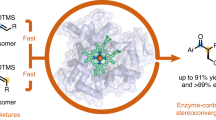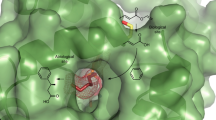Abstract
Using directed evolution, we have improved the hydantoinase process for production of L-methionine (L-met) in Escherichia coli. This was accomplished by inverting the enantioselectivity and increasing the total activity of a key enzyme in a whole-cell catalyst. The selectivity of all known hydantoinases for D-5-(2-methylthioethyl)hydantoin (D-MTEH) over the L-enantiomer leads to the accumulation of intermediates and reduced productivity for the L-amino acid. We used random mutagenesis, saturation mutagenesis, and screening to convert the D-selective hydantoinase from Arthrobacter sp. DSM 9771 into an L-selective enzyme and increased its total activity fivefold. Whole E. coli cells expressing the evolved L-hydantoinase, an L-N-carbamoylase, and a hydantoin racemase produced 91 mM L-met from 100 mM D,L-MTEH in less than 2 h. The improved hydantoinase increased productivity fivefold for >90% conversion of the substrate. The accumulation of the unwanted intermediate D-carbamoyl-methionine was reduced fourfold compared to cells with the wild-type pathway. Highly D-selective hydantoinase mutants were also discovered. Enantioselective enzymes rapidly optimized by directed evolution and introduced into multienzyme pathways may lead to improved whole-cell catalysts for efficient production of chiral compounds.
This is a preview of subscription content, access via your institution
Access options
Subscribe to this journal
Receive 12 print issues and online access
$209.00 per year
only $17.42 per issue
Buy this article
- Purchase on Springer Link
- Instant access to full article PDF
Prices may be subject to local taxes which are calculated during checkout





Similar content being viewed by others
References
Stinson, S.C. Counting on chiral drugs. Chem. Eng. News 76, 83–104 (1998).
Syldatk, C., Müller, R., Siemann, M. & Wagner, F. Microbial and enzymatic production of D-amino acids from DL-5-monosubstituted hydantoins. In Hydrolysis and formation of hydantoins in biocatalytic production of amino acids and derivatives. Biocatalytic production of amino acids and derivitives. (eds Rozzell, J.D. & Wagner, F.) 75–127 (Hanser Publisher, New York; 1992).
Syldatk, C., Müller, R., Pietzsch, M. & Wagner, F. Microbial and enzymatic production of L-amino acids from DL-5-monosubstituted hydantoins. In Hydrolysis and formation of hydantoins in biocatalytic production of amino acids and derivatives. (eds Rozzell, J.D. & Wagner, F.) 131–1176 (Hanser Publisher, New York; 1992).
Drauz, K. Chiral amino acids: a versatile tool in the synthesis of pharmaceuticals and fine chemicals. Chimia 51, 310–314 (1997).
Wagner, F., Hantke, B., Wagner; T., Drauz K. & Bommarius, A. Microorganism, use thereof and process for the production of L-alpha-amino acids. US 5714355 (1998).
May, O. et al. Substrate-dependent enantioselectivity of a novel hydantoinase from Arthrobacter aurescens DSM 3745: purification and characterization as a new member of cyclic amidases. J. Biotechnol. 61, 1–13 (1998).
Wagner, T., Hantke, B. & Wagner, F. Production of L-methionine from D,L-5-(2-methylthioethyl)hydantoin by resting cells of a new mutant strain of Arthrobacter species DSM 7330. J. Biotechnol. 46, 63–69 (1996).
Völkel, D. & Wagner, F. Reaction mechanism for the conversion of 5-monosubstituted hydantoins to enantiomerically pure L-amino acids. Ann. NY Acad. Sci. 750, 1–9 (1995).
Arnold, F.H. & Moore, J.C. Optimizing industrial enzymes by directed evolution. Adv. Biochem. Eng. Biotechnol. 58, 1–14 (1997).
Arnold, F.H. & Wintrode, P.L. Fermentation, biocatalysis, and bioseparation. In Encyclopedia of bioprocess technology (eds Flickinger, M.C. & Drew, S.W.) 971–987 (John Wiley & Sons, New York, NY; 1999).
Matcham, G.W. & Bowen, A.R.S. Biocatalysis for chiral intermediates: meeting commercial and technical challenges. CHIM. OGGI 14, 20–24 (1996).
Reetz, M.T., Zonta A., Schimossek K., Liebeton, K. & Jaeger, K.-E. Creation of enantioselective biocatalysts for organic chemistry by in vitro evolution. Angew. Chem. Int. Edn. Engl. 36, 2830–2832 (1998).
Reetz, M.T. & Jaeger, K.-E. Superior biocatalysts by directed evolution. Top. Curr. Chem. 200, 31–57 (1999).
Miyazaki, K. & Arnold, F.H. Exploring nonnatural evolutionary pathways by saturation mutagenesis: rapid improvement of protein function J. Mol. Evol. 49, 716–720 (1999).
Handelsman, J., Rondon, M.R., Brady, S.F., Clardy, J. & Goodman, R.M. Molecular biological access to the chemistry of unknown soil microbes: a new frontier for natural products. Chem. Biol. 5, R245–R249 (1998).
Fersht, A. (ed.) Enzyme structure and mechanism. (W.H. Freeman and Co., New York, NY; 1985).
Wilms, B. et al. Cloning, nucleotide sequence and expression of a new L-N-carbamoylase gene from Arthrobacter aurescens DSM 3747 in E. coli. J. Biotechnol. 68, 101–113 (1999).
Volff, J.-N., Eichenseer, C., Viell, P., Piendl, W. & Altenbuchner, J. Nucleotide sequence and role in DNA amplification of the direct repeats composing the amplificable element AUDI of Streptomyces lividans 66. Mol. Microbiol. 21, 1037–1047 (1996).
Rose, R.E. The nucleotide sequence of pACYC184. Nucleic Acids Res. 16, 355 (1988).
Yanisch-Perron, C., Viera, J. & Messing, J. Improved M13 phage cloning vectors and host strains: nucleotide sequences of the M13mp18 and pUC vectors. Gene 33, 103–109 (1984).
Luria, S.E., Adams, J.N. & Ting, R.C. Transduction of lactose-utilizing ability among strains of Escherichia coli and Shigella dysenteriae and properties of phage particles. Virology 12, 348–390 (1960).
Chen, C.S., Fujimoto, Y., Girdaukas, G. & Sih, C.J. Quantitative analysis of biochemical kinetic resolutions of enantiomers. J. Am. Chem. Soc. 104, 7294–7299 (1982).
Acknowledgements
We thank Dr. Joe Altenbuchner and Dr. A. Wiese for kindly providing vector pJOE2702 and the racemase gene from Arthrobacter aurescens DSM3747, respectively, and Dr. W. Günther for his support in HPLC analytics. We also thank Dr. A. Bommarius for reading the manuscript and useful discussions and J. Ladd for his excellent technical assistance. This work was financed by Degussa-Huels AG. We also thank the Caltech SURF program for support of undergraduate research (P.N. and J. Ladd).
Author information
Authors and Affiliations
Corresponding author
Rights and permissions
About this article
Cite this article
May, O., Nguyen, P. & Arnold, F. Inverting enantioselectivity by directed evolution of hydantoinase for improved production of l-methionine. Nat Biotechnol 18, 317–320 (2000). https://doi.org/10.1038/73773
Received:
Accepted:
Issue Date:
DOI: https://doi.org/10.1038/73773
This article is cited by
-
Merging enzymatic and synthetic chemistry with computational synthesis planning
Nature Communications (2022)
-
Ancestral L-amino acid oxidases for deracemization and stereoinversion of amino acids
Communications Chemistry (2020)
-
The 2018 Nobel Prize in Chemistry: Engineering proteins (enzymes/peptide/antibodies) towards desired properties via the construction of random libraries
Science China Life Sciences (2019)
-
Toward a cell-free hydantoinase process: screening for expression optimization and one-step purification as well as immobilization of hydantoinase and carbamoylase
AMB Express (2017)
-
Hydantoinasen – von der präbiotischen Evolution zur Aminosäureproduktion
BIOspektrum (2017)



